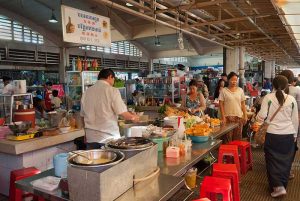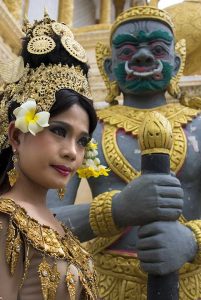Wherever you travel on planet Earth, you’ll always get a positive response when you learn a little of the local lingo. You’ll also have a definite edge at the local markets or if you find yourself in a precarious situation. Cambodians seem particularly impressed and grateful when visitors learn basic Khmer, possibly due to the fact it’s spoken in so few countries. It’s a beautiful language, and one of the oldest in South-East Asia, so let’s get acquainted with the basics and create a cheat sheet that will help you connect with locals and hopefully earn a little favouritism.
Learn basic Khmer 1 – Greetings, traveling, important vocab, common sentences
While many people are daunted by the complexity of Khmer, especially the fact that it involves learning the largest alphabet in the world, it’s very easy to pick up the basics because in many cases it follows the same logic as the English language. For native English speakers, the toughest challenges will be structuring sentences, rolling the letter ‘R’, and working out how to address people according to age.
Let’s start by saying hello

In general, once you get down to street level, rules are broken and most language formalities are ignored. The main exceptions are formal greetings, which are lovely when used in the right circumstances (e.g. if you’re invited to a Khmer family’s home), and the unbreakable rules related to gender and age, which are listed/explained below. Don’t worry, they are quite simple. Keep in mind that most of these anglicised versions of Khmer words are simplified. We’ll take a ‘near enough is good enough’ approach rather than force you to learn the 23 vowels, many of which are pronounced differently depending on consonants.
Vocab:
I / I am / me: Knyom
You (older person or similar age): bong
You (younger person): on
Yes (if you are male): baht
Yes (if you are female): jah
No: ot-tay
Hello (formal): choom reap soo-er
Goodbye (formal): choom reap lee-ah
Note: the two formal terms above are always accompanied by the ‘sampeah’ (placing the hands in a prayer pose), and the more important the person you greet, the higher you raise your hands (usually fingertips below the chin is fine). If someone greets you in this manner, respond with a sampeah. As you explore popular cities like Phnom Penh, you’ll rarely see the sampeah, but many stores train employees to use it so be prepared to react appropriately.
Hello (casual): suo-s’day
Goodbye (casual): lee-ah
Happy: soksah-bye
Same: doi k’nia
Thank you: orkoun
Meet: choob
Together: k’neah
Time: pel
Next: k’raou-ee
Many: j’ran
 Conversation (basic greeting)
Conversation (basic greeting)
Note: the sentence structure will be explained in brackets after the Khmer translation, just in case you want to learn syntax and create your own sentences.
How are you?
Bong/on, soksah-bye tay? (you happy, no?)
Yes, I am well. And you?
Baht/Jah, knyom soksah-bye. Cho bong/on? (yes, I’m happy, and you?)
The same. I’m happy.
Doi k’nia. Knyom soksah-bye. (same, I’m happy)
Thank you.
Orkoun
Thanks very much
Orkoun j’ran (thanks, many)
See you next time
Khmer: choob k’nea pel k’raou-ee (meet together next time)
Hit the road
Besides the simplest greetings, the first words that will stick in your memory will be directions. You’ll use them often as you explore Phnom Penh, usually in tuk tuks or auto-rickshaws. If you have a map, you can tell the driver you know the location and direct them with these terms.
Please: som
Excuse me: som-toh
We: yerng
To know (a person or location): skol
Go: doe
Straight: trong
Turn: bort
Left: chwayng
Right: sadam
Here: deenith
There: deenouth
This one: Ai-nith
Stop: chob
Slowly: yute yute
Fast: luen
Little bit: tik tik
Very: nah
How much: bon marn
Expensive: t’lye
Riverside: mote tun-lye
Palace: veang
Hotel: sontah-kea
Restaurant: pojo nitan
Where: erna
Where at: no-erna
Want: jong
Not: ot
No problem: ot bun-yah-ha
Wait: jam
See: kern
One: moy
Two: bee
Three: buy
Four: buan
Five: bram
 Conversation with tuk tuk driver
Conversation with tuk tuk driver
Note: ‘bong’ and ‘on’ are also used as generic references for people, similar to how you might use words like mate or pal when referring to someone casually. In Khmer they basically mean brother/sister. Once you understand that, it adds a very friendly tone to all conversations. You’ll notice I’ve used many instances of it below. That’s not unrealistic. We constantly use it in conversations. To learn basic Khmer, you need to get a grasp of how common it is to use these more familiar (or family-oriented) salutations. Below we’ll use ‘bong’, but remember to use ‘on’ for younger people.
Hello.
Suo-s’day, bong.
Do you know ______ hotel?
Bong skol ______ pojo nitan?
No. I don’t know it.
Ot tay. Knyom ot skol.
No problem. I know. Close to the palace.
Ot bun-yah-ha. Knyom skol. Pojo nitan chet noh veang. (not problem, I know, hotel near place)
Okay.
Baht bong.
Wait a second. How much?
Jam tik. Bon marn?
Five dollars.
Bram dollar.
Sorry. Too expensive. Two dollars?
Som toh. T’lye nah. Bee dollar? (sorry, expensive very, two dollars?)
Three?
Buy?
Okay.
Okay, bong.
Please go straight.
Som doe trong.
Yes.
Baht bong.
Turn left.
Bort chwayng
Turn right?
Bort sadam?
No. Go straight. Please slow down a little bit. There.
Ot tey. Doe trong. Yute yute tik. Deenouth.
This one?
Ai-nouth?
Yes. Please stop here.
Baht. Som chob deenith.
Thanks.
Orkoun
Thanks very much.
Orkoun j’ran.
 Essential words for common requests
Essential words for common requests
When you start to learn basics Khmer, the reality is that most of your first conversations will be one-way traffic. When you try some of the basic sentences, you’re bound to speak well enough for a Cambodian person to get excited about your knowledge of the language. You might be at a local market and suddenly be stunned as a Cambodian speaks to you at a hundred miles an hour. Don’t worry about it. The most important thing is to be able to let people know what you need because that gives them an opportunity to help you. English is spoken by many Cambodians but you don’t want to hit a language barrier at any time, especially in an urgent situation.
Below are important words and basic phrases that you should be able to tailor to create the right phrase for most scenarios.
Want: jong
Need: trove-kah
Like: joljet
Sick: chur
Medicine: t’nam
Hospital: mun-ti pet
Hungry: kah-lean
Eat / drink: nyam
Water: tuk
Toilet: bontub tuk
One more: moy tiet
The bill please: som ket loi
Market: p’sah
Thief: jau
Embassy: sit-tan toot
Airport: prolean mun-ho
This: nih
That: noah
Come: moke
Come back: moke win
Arrive: moke dole
What (as part of a question): aye
What (on its own): ek-aye
Where: er-na
He/she: gwat
Friend: pu-mah
Husband: p’dei
Wife: bro-poun
My: robo knyom
Some useful sentences
You’ll find that if you use these sentence structures with the vocab I’ve listed, you can customise each sentence to fit many scenarios. Notice how verbs create a sentence structure that is similar to English but other sentences must begin with a subject followed by adjectives or adverbs.
My wife is sick.
Bro-pun robo knyom chur (wife mine sick).
She needs medicine.
Gwat trove-kah t’nam
We are going to the airport.
Yerng doe prolean mun-ho
Can I get the bill please?
Som ket loi. (please think money)
Where is the market?
P’sah noh erna? (market at where/)
What is this?
Nih aye? (this what)
He is my friend.
Gwat pu-mah robo knyom. (he friend mine)
When do we arrive?
Yerng moke dol, pel na? (we arrive when)
I know a little bit of Khmer.
Khnom jet Khmer tik tik. (I know khmer a little)
The worst thing that can happen
You need to be a little adventurous to get rewards when you learn basic Khmer. There’s a good chance you’ll gain a better insight into the culture and win a few hearts. The worst that can happen is you’ll all have a laugh. Cambodians love to make fun of each other so you may be the brunt of a few jokes, but you’ll also be applauded for the effort. It’s well worth the risk, and certainly worth knowing how to get yourself out of a tight jam.
My final advice is that you speak as quickly as possible. Context is your greatest ally, so the more words you can string together quickly, the more understandable you’ll be. Many of the vowels in the Khmer language don’t exist in English, but the odd pronunciation error will be cleared up if the listener can understand context. There’s nothing wrong with structuring a request on paper, rehearsing it, and then trying it. Some of the more common phrases should become second nature within a couple of days.
Have a great stay and drop into the Pacific Hotel or Barb & Lotus for a meal or drink, along with a few more language tips. Feel free to comment below with any language requests you’d like us to consider for our next blog. Next time we’ll do some shopping, learn a few more numbers and prepare you for more traveling in Cambodia.
